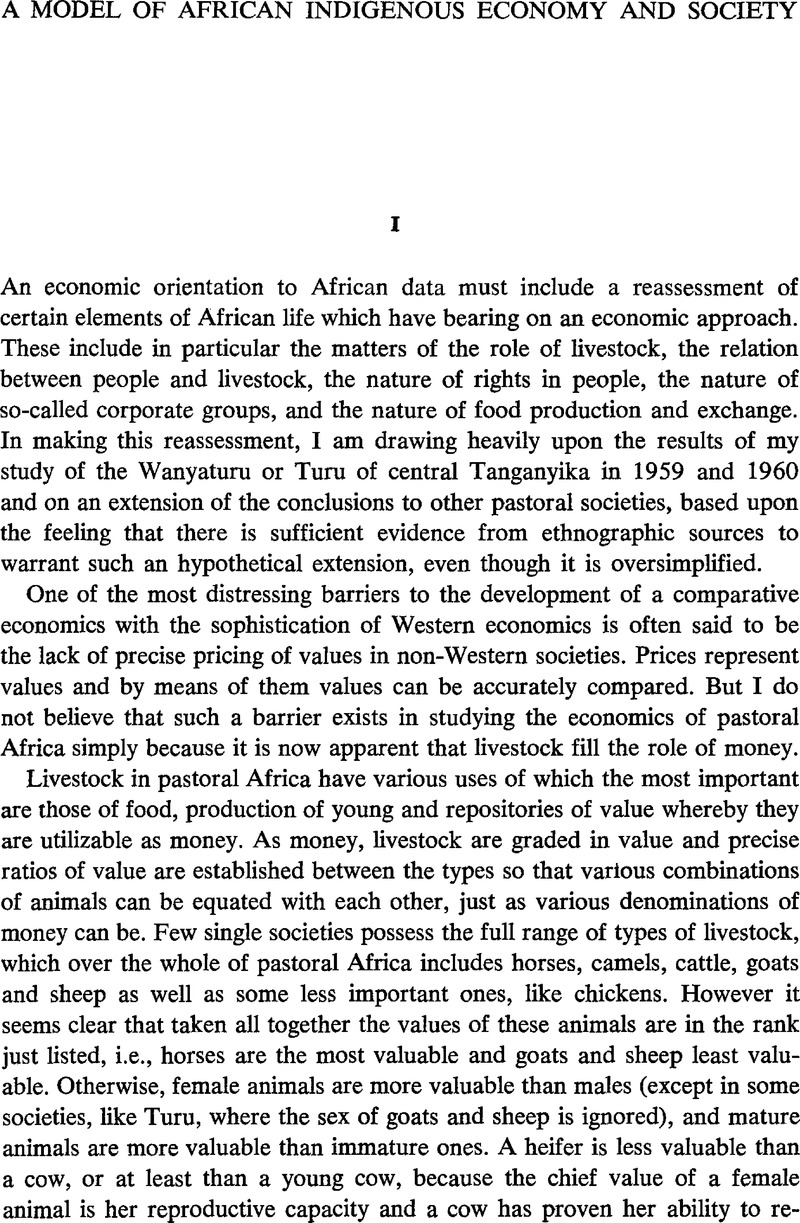Published online by Cambridge University Press: 03 June 2009

1 Murdock, G.P., “African Cultural Summaries”, unpublished MS (New Haven, 1958),Google Scholar summary FN18, p. 2.
2 Schneider, H.K., “Economics in East African Aboriginal Societies”, in Herskovits, M.J. and Harwitz, M. (eds.), Economic Transition in Africa (Evanston, 1964), pp. 53–75.Google Scholar
3 Lewis, I.M., Marriage and the Family in Northern Somaliland (=; East African Studies, No. 15) (East African Institute of Social Research, Kampala, 1962), p. 2.Google Scholar
4 Huntingford, G.W.B., The Galla of Ethiopia (London, 1955), p. 62.Google Scholar
5 Richards, A.I., “Some Types of Family Structure amongst the Central Bantu”, in A. R. Radcliffe-Brown and D. Forde, African Systems of Kinship and Marriages (London, 1950), p. 226.Google Scholar
6 Girling, F.K., The Acholi of Uganda (London, 1960), p. 66.Google Scholar
7 Tempels, P., Bantu Philosophy (Paris, 1959), p. 30 ff.Google Scholar
8 I. M. Lewis, op. cit., pp. 39–40.
9 Pamela and Gulliver, P.H., The Central Nilo-Hamites (London, 1953), p. 81.Google Scholar
10 Gray, R.F., The Sonjo of Tanganyika (London, 1963), pp. 71 ff.Google Scholar
11 Pamela and P. H. Gulliver, op. cit., p. 82.
12 Fortes, M., “The Structure of Unilineal Descent Groups”, American Anthropologist, Vol. 55, (1953, No. 1), p. 26.CrossRefGoogle Scholar
13 Ibid., p. 24.
14 Pamela and P. H. Gulliver, op. cit., p. 81.
15 For example this claim is one of the features of many of the essays in Bohannan, Paul and Dalton's, GeorgeMarkets in Africa (Evanston, 1962).Google Scholar
16 I. M. Lewis, ‘Trade and Markets in Northern Somaliland” in Bohannan and Dalton, op. cit., pp. 371–72.
17 M. Gluckman, “Kinship and Marriage Among the Lozi of Northern Rhodesia and the Zulu of Natal”, in Radcliffe-Brown and Forde, op. cit.
18 I. M. Lewis, op. cit.
19 I. M. Lewis, Marriage and the Family in Northern Somaliland, op. cit., p. 41.
20 M. Gluckman, op. cit., A. I. Richards, op. cit.
21 Richards, Ibid., p. 250.
22 M. Gluckman, op. cit., p. 193.
23 Schneider, David and Gough, Kathleen (eds.), Matrilineal Kinship (Berkeley, 1961).Google Scholar
24 Ibid., p. 680.
25 Leach, E.R., “Aspects of Bridewealth and Marriage Stability Among the Kachin and Lakher”, in Rethinking Anthropology (London, 1961), pp. 114–123.Google Scholar
26 Mitchell, J.C., “The Yao of Southern Nyasaland”, in Colson, E. and Gluckman, M. (eds.), Seven Tribes of British Central Africa (Manchester, 1959), pp. 326–327.Google Scholar
27 The sources consulted to obtain data for the construction of this chart are as follows: J. A. Barnes, op. cit., Ngoni; M. Tew, op. cit., Ngoni, Nyakyusa, Yao; Butt, A., The Nilotes of the Anglo-Egyptian Sudan and Uganda (London, 1952),Google Scholar Shilluk, Luo, Dinka, Nuer, Acholi; Prins, A.H.J., The Coastal Tribes of the North-Eastern Bantu (London, 1952),Google Scholar Pokomo, Teita, Digo; W. Whiteley, Bemba and Related Peoples of Northern Rhodesia and Slaski, J., Peoples of the Lower Luapula Valley (London, 1951),Google Scholar Ambo, Lamba, Kaonde, Bemba, Eastern Lunda; F. K. Girling, op. cit., Acholi; A. I. Richards, op. cit., Bemba; Manoukian, M., Tribes of the Northern Territories of the Gold Coast (London, 1952),Google Scholar Tallensi; Vansina, J., Les Tribus Ba-Kuba et les Peuplades apparentées (London, 1954,Google Scholar Bakuba, Bashilele, Bawongo; J. C. Mitchell, op. cit., Yao; Taylor, B.K., The Western Lacustrine Bantu (London, 1962),Google Scholar Nyoro, Toro, Amba, Haya, Konjo; Sheddick, V.G.J., The Southern Sotho (London, 1953),Google Scholar Basuto; Pamela and P. H. Gulliver, op. cit., Teso, Jie, Turkana; McCulloch, Merran, The Ovimbundu of Angola (London, 1952),Google Scholar Ovimbundu; McCullock, Merran, The Southern Lunda and Related Peoples (London, 1951),Google Scholar Southern Lunda, Chokwe, Luena; Geluwe, H. Van, Les Bira et les Peuplades Limitrophes (London, 1957),Google Scholar Bira; Burssens, H., Les Peuplades de L'entre Congo-Ubangi (London, 1958),Google Scholar “Congo-Ubangi”; Jaspan, M.A., The Ila-Tonga Peoples of North-Western Rhodesia (London, 1953),Google Scholar Ila, Tonga; Turner, V.W., The Lozi Peoples of North-Western Rhodesia (London, 1952),Google Scholar Lozi; M. Gluckman, op. cit., and “The Lozi of Barotseland in North-Western Rhodesia”, in Colson and Gluckman, op. cit., Lozi; Gunn, H.D., Peoples of the Plateau Area of Northern Nigeria (London, 1953),Google Scholar Birom; Fallers, M.C., The Eastern Lacustrine Bantu (London, 1960),Google Scholar Ganda, Soga; Cerulli, E., Peoples of South-West Ethiopia and its Borderland (London, 1956),Google Scholar Ingassana, Mao, Didinga; Forde, D., Peoples of the Niger-Benue Confluence: The Nupe (London, 1955),Google Scholar Nupe; Bradbury, R.E., The Benin Kingdom (London, 1957),Google Scholar Benin; Brown, P., Peoples of the Niger-Benue Confluence: The Igbira (London, 1955),Google Scholar Igbira.
28 urssen's account of the people of the Congo-Ubangi area actually is concerned with a group of societies such as Ngbandi, Ngbaka, Mbandja, and Ngombe. However he discusses their social systems in general terms applying to all. I have chosen to make this a single case rather than arbitrarily pick one of these societies as the example.
29 J. A. Barnes, “The Fort Jameson Ngoni”, in Colson and Gluckman, ibid., pp. 228–29.
30 Tew, M., Peoples of the Lake Nyasa Region (London, 1950), p. 15.Google Scholar